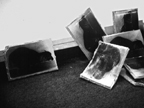Michael Maranda
fY
“Heterodoxy,” silver print, 1.5x3m2, 1995
“1992,” 100 silver prints & plaster, variable dimensions, 1995
“1995,” embossed paper, variable dimensions, 1995
statement . . .
On one wall is a single photographic image pieced together from multiple sheets of photographic paper. The
image is a negative print of a detail of a seventeenth-century fresco which depicts the bound ram which Abraham sacrificed
in place of his son. Across the bottom of the image the word “heterodoxy” is scratched into the emulsion. It
is not incidental that the photographic paper used is Pal, a silver-rich paper produced in Yugoslavia in the 1980s. The
prints are unevenly fixed, and over the course of six weeks the image darkens to a mottled reddish-brown colour.
In front of this wall are three piles of the same
image mounted onto sheets of plaster (each 24x36x3cm3). In one
pile, there are 18, in the second, 33, and the third, 39. In a corner is
a fourth pile of 10 images, an afterthought which brings the total to 100
panels. The edges of each panel are roughly broken; the surface of each
photograph distressed and coated with wax. A thick coat of plaster dust
coats each image and is worn into the floor around each pile.
On the far wall, thick sheets of handmade paper (each measuring approximately 60x90 cm2) are pinned to the wall,
two “T” pins each. The bottom edges curl in the late summer humidity of Western New York State, giving the wall
a kinetic quality — if only in the longue durée. On first sight it appears a formalist exercise in surface.
Produced over the summer of 1995, this series was made to the soundtrack of the crisis in Bosnia as reported on CNN, NPR,
and other main-stream media. Intentionally obscure, references veiled (if even revealed), this work has little to do with
the events that unfolded in the streets of Sarajevo. My studio for that summer was a sun-drenched ex-cafeteria, surrounded
on four sides by floor to ceiling windows looking out on an idyllic park on the University of Rochester campus — too
distant from the market places, cafés, and streets of the former Yugoslavia to allow me to comprehend the daily reports.
I could not allow myself the arrogance of commenting on what was happening ‘over there’ (or was it more an admission
of my own complicit helplessness.)
Instead, I wanted to come to grips with the reports that I religiously followed. The first two pieces, “heterodoxy”
and “1992,” act as foils for the larger piece. They give the long and short term backgrounds of the region.
The word, heterodoxy, points to the religious traditions of the region — all religions of the ‘book’ —
all based on various notions of orthodoxy (which translates, roughly, as ‘The One Tradition’). “1992,”
on the other hand, recounts the late twentieth century translation of these traditions — from religious doctrine to
“ethnic categories.” In 1992, the provinces of Bosnia and Herzgovina consisted of 39% Bosnians (Islamic), 33%
Serbians (Orthodox Christian), 18% Croatians (Roman Catholic), and 10% 'other.'
Against this backdrop, the main work, “1995,” turns out to be more than a consideration of surface. Closer examination
(closer examination than most viewers were willing to take) reveals in the centre of each sheet an engraved enigmatic word
(obrovac, knin, daruvar, benkovac …) in twelve point type. Faint, almost illegible (certainly unphotographable), unrecognizable
without the pronunciation of a newscaster, these are the names of Bosnian towns which I heard over the course of that summer.
exhibitions . . .
1995
• Solo. “fY,” Library Gallery (University of Rochester)
